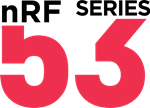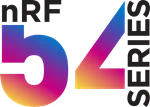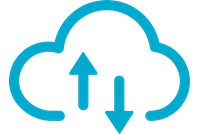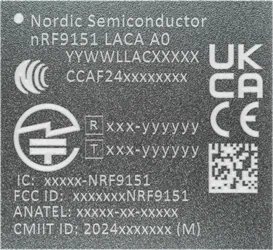Unprecedented integration
Completely integrated cellular IoT solutions
The nRF91 Series uses the Arm Cortex-M33 as a dedicated application processor, fully programmable for the user. It has 1MB of FLASH, 256kB of RAM, and a broad array of peripherals. Beyond its LTE connectivity and positioning options, the series can support a broad selection of use cases and offers real edge computing possibilities for the world of cellular IoT and DECT NR+ (nRF9151 and nRF9131). Nordic provides the open-source nRF Connect Software Development Kit that users can use to develop their customized applications on the dedicated application processor. Note, the nRF9131 mini SiP does not have an integrated PMIC and Passives and crystals.
Feature comparison of our nRF91 Series devices
| Features | nRF9160 | nRF9151 | nRF9131 |
|---|---|---|---|
| CPU | Arm Cortex-M33 @ 64MHz |
Arm Cortex-M33 @ 64MHz | Arm Cortex-M33 @ 64MHz |
| Flash / RAM | 1 MB / 256 KB | 1 MB / 256 KB | 1 MB / 256 KB |
| Arm Trustzone | ✔️ |
✔️ | ✔️ |
| Crypto acceleration | Arm Cryptocell 310 | Arm Cryptocell 310 | Arm Cryptocell 310 |
| Integrated PMIC, passives & Xtral | ✔️ |
✔️ | |
| Pre-certified | ✔️ | ✔️ | |
| LTE-M | 3GPP rel 13 | 3GPP rel 14 | 3GPP rel 14 |
| NB-IoT | 3GPP rel 13 | 3GPP rel 14 | 3GPP rel 14 |
| NTN (Non-Terrestrial Networks) | ✔️ (Coming 2025) | ||
| DECT NR+ | ✔️ | ✔️ | |
| GNSS | GPS/QZSS | GPS/QZSS | GPS/QZSS |
| Certified Bands | 1-5, 8, 12, 13, 17-20, 25, 26, 28, 66 | 1-5, 8, 12, 13, 17-20, 25, 26, 28, 65, 66, 85 | 1-5, 8, 12, 13, 17-20, 25, 26, 28, 65, 66, 85 |
| Frequency | 700-2200 MHz | 700-2200 MHz (LTE) 915 MHz and 1.9 GHz (NR+) |
700-2200 MHz (LTE) 1.9 GHz (NR+) |
| Maximum TX Power | 23 dBm | 23 dBm | 23 dBm |
| Power Class 5 20dBm | ✔️ | ||
| SGP.02/SGP.22/SGP.32 support | ✔️ | ✔️ | ✔️ |
| nuSIM | ✔️ | ✔️ | ✔️ |
| Onomondo SoftSIM | ✔️ | ✔️ | ✔️ |
| Supply Voltage Range | 3.0 to 5.5 V | 3.0 to 5.5 V | 3.0 to 5.5 V (dependent on ref. design) |
| Operating temperature | -40 to 85°C | -40 to 85°C | -40 to 85°C |
| Package options | 10x16x1.04 mm LGA | 11x12x1 mm LGA | 7x11x0.74 mm LGA |
Cellular IoT SiPs
nRF91 Series
Supported PMICs
nPM1300 PMIC
Power Management IC (PMIC) with unique system management features
The nPM1300 is designed to provide highly efficient power regulation for Nordic’s nRF52 and nRF53 Series, as well as the nRF54L and nRF54H Series wireless multiprotocol Systems-on-Chip (SoC). The PMIC is also suitable for battery charging for applications based on the nRF91 Series systems-in-package (SiPs) for cellular IoT, by using the PMIC’s unregulated output to power the SiP's internal buck regulators.
Devices using the nPM1300 and a compatible SoC or SiP also get access to the Nordic Fuel Gauge, a highly accurate, ultra-low-power way of estimating state-of-charge of rechargeable batteries.
Certifications
Certified for global operations
nRF91 Series certifications
Our team of test and certification engineers is traveling the world to secure certifications for operations in all key regions and with all major operators.
Modules
Hit the market faster with pre-certified modules
3rd party cellular modules
Since chipset designs are complex and heavy on certification effort in cellular, Nordic provides a pre-certified module. To further simplify integration into a product, 3rd parties offer cellular modules that are assembled preapproved as end-products.
Perfect companions
Expanding your cellular applications with Nordic nPM Family PMICs, nRF70 Wi-Fi Companion ICs, Nordic's multiprotocol SoCs and nRF Cloud Services for limitless opportunities
-
SSID Wi-Fi locationing and nRF91 Series
![a circuit board for nbiot [nbiot],cellular module](/-/media/Images/Products/Wi-Fi/nRF7002-QFN48-6x6-on-PCB_1.jpg?h=134&w=200&hash=A65399FFEFF0E625692AA50FBE20FC38)
Wi-Fi Companion IC: Enhances the nRF91 Series with SSID-based Wi-Fi Location
The nRF70 Series offers SSID-based Wi-Fi Location functionality, providing an incredibly effective method for obtaining low-power location data for devices situated both indoors and outdoors. By pairing an nRF70 Series device with an nRF91 Series device, a multitude of optional location services are available for applications utilizing the optimized nRF Cloud Location services. Depending on the desired accuracy and power consumption requirements, users can employ any combination of the following services: Assisted-GPS, Predicted-GPS, Multi-cell, Single-cell, and SSID Wi-Fi-based location services.
-
Multiprotocol SoCs and nRF91 Series



Empowering short range technologies: Unleashing the potential of the Nordic's multiprotocol SoCs
The Nordic's multiprotocol SoCs, comprising nRF52, nRF53, and the latest nRF54 Series, offers unparalleled capabilities to seamlessly integrate short range technologies into your cellular applications. Whether it's Bluetooth Low Energy, Thread, Zigbee, or Matter, these devices present an exceptional choice. Renowned for their reliability and performance, they serve as trusted solutions to elevate any cellular application that necessitates communication through various short range protocols. Moreover, these devices enable the flexibility of future-proofing your end product by leveraging Firmware over the Air updates to unlock additional functionalities.
-
PMICs and nRF91 Series
![Front of an IC saying NPM1300, QEAAB0, 2302AC, with back showing QFN pads - nbiot [nbiot],cellular module](/-/media/Images/Products/PMICs/nPM1300/nPM1300_QFN32_5x5_stacked_web.png?h=199&w=200&hash=C0D9DA83346640751525428E2C82744A)
Powerful Power Management: The perfect PMIC for nRF91 Series devices for cellular IoT applications.
The nPM1300 Power Management IC (PMIC) is the perfect PMIC for the nRF91 Series that utilize rechargeable batteries. This versatile PMIC offers a range of exceptional features, including a low power fuel gauge for accurate battery monitoring, an external watchdog timer for reliable system reset, and support for additional GPIOs and three extra LEDs. With the nPM1300 PMIC and nRF91 Series devices, you can optimize power management, gain real-time insight into battery life, ensure system reliability, and enhance functionality for your cellular IoT application. Unleash the full potential of your product with this powerful combination.
-
nRF Cloud and nRF91 Series

IoT Services platform optimized for the nRF91 Series
Experience the ultimate IoT services platform tailored exclusively for the nRF91 Series, the nRF Cloud. Unlike other cloud solutions that overlook the unique requirements of low power devices and constrained protocols, nRF Cloud is specifically optimized for Nordic devices, ensuring unparalleled performance and efficiency.
Unlock the potential of nRF Cloud and gain access to cutting-edge services designed to enhance your application. Our advanced location services offer a wide range of options, including Assisted GPS, Predicted GPS, Multicell, Singlecell, and SSID Wi-Fi-based locationing. No matter your power consumption or accuracy needs, we have you covered.
nRF Cloud also supports CoAP protocol, a UDP-based network protocol specifically designed for low power devices. Whether you're using LTE-M or NB-IoT, CoAP seamlessly integrates and delivers exceptional results.
But that's not all. nRF Cloud provides top-notch security services and device management features to give you the utmost peace of mind.
.png?h=512&w=800&hash=AA2819A1F581FB936460ACDE91D6081A)
![nRF9160 SiP rev2 10×16 front.png nrf9160 sip for nbiot [nbiot],cellular module](/-/media/Images/Products/SiP/nRF9160-SiP/nRF9160-SiP-rev2-1016-front.png?h=250&iar=0&mh=250&w=382&hash=D70F3088259A7FE96AA8F63696342B52)


![nRF9131_SiP_Top_reduced_size.png nrf9131 mini sip for nbiot [nbiot],cellular module](/-/media/Images/Products/SiP/nRF9131-mini-SiP/nRF9131_SiP_Top_reduced_size.png?h=250&iar=0&mh=250&w=393&hash=62BB07B2A5FEBDC717952B2D9266A175)
